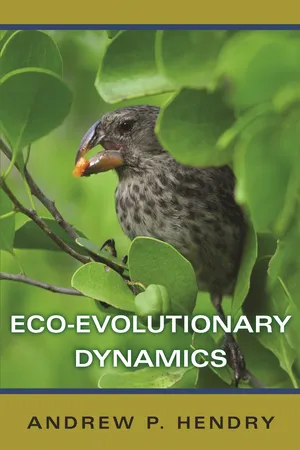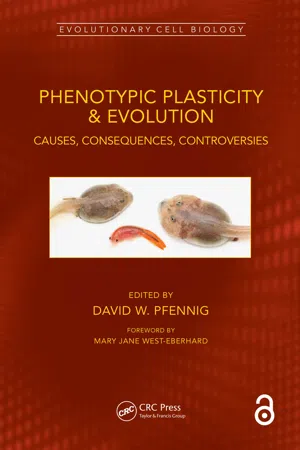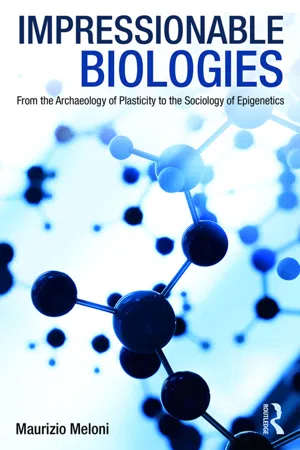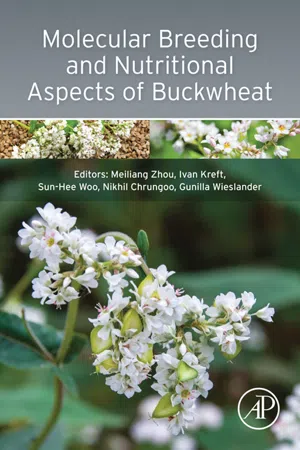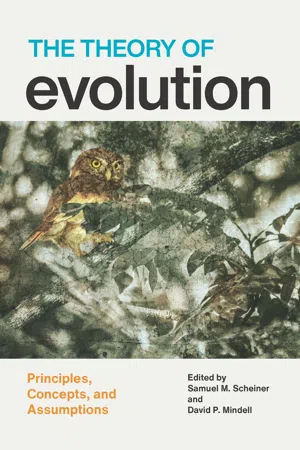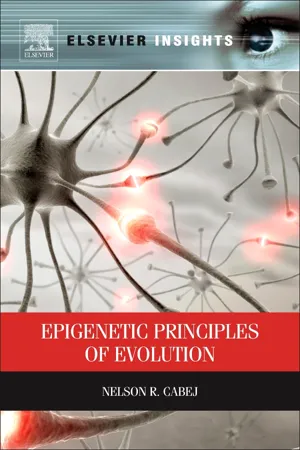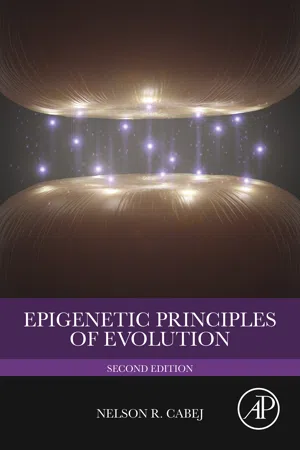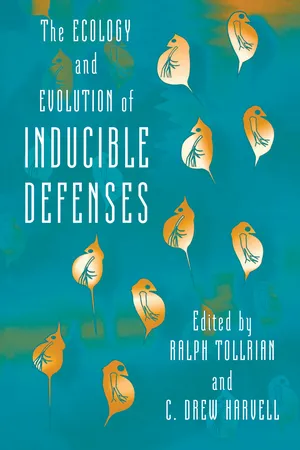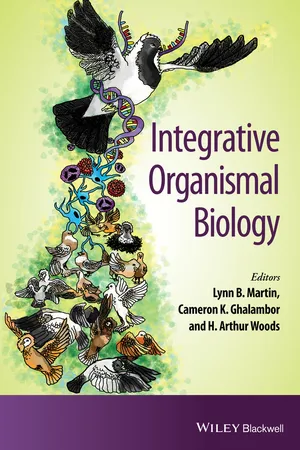Biological Sciences
Phenotypic Plasticity
Phenotypic plasticity refers to the ability of a single genotype to produce different phenotypes in response to environmental changes. This allows organisms to adapt to varying conditions without genetic changes. Phenotypic plasticity is important for survival and reproduction in fluctuating environments, and it plays a significant role in evolution and ecological interactions.
Written by Perlego with AI-assistance
Related key terms
Related key terms
1 of 4
Related key terms
1 of 3
10 Key excerpts on "Phenotypic Plasticity"
- Barbara A. Ambrose, Michael D. Purugganan(Authors)
- 2012(Publication Date)
- Wiley-Blackwell(Publisher)
Chapter 10 DEVELOPMENT IN THE WILD: Phenotypic Plasticity Kathleen Donohue Biology Department, Duke University, Durham, NC, USAAbstract: Development of organisms in the wild occurs in ecologically variable environments. Phenotypic Plasticity occurs when a single genotype alters its phenotype in response to its environment. Some traits are more plastic than others, and whether a particular trait evolves plasticity depends on the degree of environmental variation experienced by that trait, the quality of environment-dependent natural selection on that trait, and the strength of genetic correlations between the trait expressed in different environments. Thus, identifying the molecular basis of pleiotropy of traits expressed in different environments should be an important agenda in studies of development and plasticity. The strength of pleiotropy across environments can be influenced by environment-dependent gene expression and signal transduction and by the structure of genetic pathways. The degree of environmental dependence of many of these molecular processes, however, is only beginning to be elucidated. Phenotypic Plasticity influences adaptation, niche breadth, and ecological ranges and has the potential to influence the evolution of reproductive isolation. Understanding the genetic and ecological mechanisms of plasticity, therefore, will enhance our knowledge of the genetic basis of adaptation and the evolution of diversity.Keywords: adaptation; epigenetics; gene expression; parental effects; phenology; phytochrome; plasticity.10.1 Development in the wild is Phenotypic PlasticityPlant form is the product of a developmental sequence in which events that occur at early life stages shape events at later life stages. In the wild, this temporal sequence of development occurs within a temporal sequence of seasons and changing ecological conditions. The moist and sunny conditions that a new germinant experiences in early spring do not persist: the canopy closes, the days grow longer, rain showers stop, insects hatch out, fungal spores mobilize, and soil microbes grow, die, replace each other, and alter the soil. Development in the wild is not merely the unfolding of a programmed protocol encoded by DNA sequences. It is a constant dialog between the ecological environment and the developmental processes that determine morphology, physiology, and behavior. It comes down to the interaction between the environment and genes.- eBook - ePub
- Andrew P. Hendry(Author)
- 2016(Publication Date)
- Princeton University Press(Publisher)
Chapter 11 PlasticityEco-evolutionary dynamics are driven by interactions between environmental features and organismal phenotypes. Although it can be tempting, or at least convenient, to assume that phenotypic change is the result of genetic evolution, a likely alternative is that environmental conditions influence the expression of phenotypic traits for a given genotype. In its various guises, this phenomenon is discussed as Phenotypic Plasticity, developmental plasticity, environmental induction, acclimation, epigenetics, induced defenses, maternal effects, genotype-by-environment interaction (GxE), and indirect genetic effects (West-Eberhard 2003, Wolf and Wade 2009). Plasticity in these various manifestations can influence ecological dynamics through several effects (Miner et al. 2005, Yamamichi et al. 2011, Kovach-Orr and Fussmann 2013, Fischer et al. 2014), which I here briefly list and later discuss in more detail. First, current levels of plasticity are expected to have evolved as a result of past selection, and so plastic changes expressed by individuals in the present can be adaptive and have a genetic basis. In such cases, plasticity can be viewed as a contemporary expression of past evolution. Second, plasticity can evolve on contemporary time scales, and so phenotypic changes in a population can reflect the ongoing evolution of plasticity. Third, plasticity modifies selection on genotypes, and thereby influences evolutionary responses to ecological change and ecological responses to evolutionary change. In short, plasticity must be an integral part of any general framework for eco-evolutionary dynamics.Plasticity has been the focus of considerable interest, with summaries of its theoretical and empirical development appearing in several books (Schlichting and Pigliucci 1998, West-Eberhard 2003). Of particularly recent popularity has been the concept of epigenetics, whereby genetic changes (e.g., DNA methylation or stable chromatin modifications) that do not alter the DNA sequence have phenotypic effects that can be heritable (Feil and Fraga 2012, Duncan et al. 2014, Schlicting and Wund 2014). Stated another way, epigenetics provides a genetic mechanism for plasticity and its propagation across generations. My focus in the present chapter will be on interactions between environment and phenotype, and so I will not be concerned with the precise genetic mechanisms. In addition, my specific focus will be on key features of plasticity that are especially relevant for eco-evolutionary dynamics. Another version of this chapter was published as Hendry (2016). - eBook - ePub
Phenotypic Plasticity & Evolution
Causes, Consequences, Controversies
- David W. Pfennig(Author)
- 2021(Publication Date)
- CRC Press(Publisher)
Section II Causes of Plasticity From Genes to EcologyPassage contains an image
Ilan Goldstein and Ian M. Ehrenreich University of Southern California4 Genetic Variation in Phenotypic PlasticityCONTENTS
4.1 Introduction 4.2 The Geneticist’s View of Phenotypic Plasticity 4.3 Modification of Heritable Phenotypic Variation by the Environment 4.4 Methods for Genetically Dissecting Phenotypic Plasticity 4.5 Empirical Insights into the Genetics of Phenotypic Plasticity 4.6 The Future of the Genetics of Phenotypic Plasticity 4.7 Conclusions Acknowledgments References4.1 Introduction
Most traits of human interest vary among individuals within a population due to a combination of genetic and environmental factors, meaning individuals’ phenotypes will depend on both their genotypes and environments. This relationship between genotype, environment, and phenotype is a major area of research that is central to our understanding of genetics in the real world (Falconer and Mackay 1996; Lynch and Walsh 1998). Indeed, whether the goal be to breed crops that maximize yield in particular climates (Kang 1997; Gage et al. 2017; Lowry et al. 2019), to predict, prevent, and treat hereditary disorders (Hunter 2005; Baye et al. 2011; Manuck and McCaffery 2014), or to understand the mechanisms underlying adaptation to changing environmental conditions (Bradshaw 1965; Via and Lande 1985; Scheiner 1993), all of these topics require knowledge of how genotype and environment jointly produce phenotype.Scientists can learn about the relationship between genotype, environment, and phenotype by studying Phenotypic Plasticity, the ability of a genotype to produce different phenotypes in response to different environments (Bradshaw 1965; Scheiner 1993; Pigliucci 2001; West-Eberhard 2003). Within genetically diverse populations, distinct genotypes will commonly show differences in plasticity (Ehrenreich and Pfennig 2016). Geneticists dissect this heritable variation in plasticity in order to better determine the impact of environment on the relationship between individuals’ genotypes and phenotypes (Debat and David 2001; Rockman 2008; Mackay et al. 2009). Here, we review genetic research on variation in plasticity. In addition to summarizing key concepts and methods, we also attempt to synthesize current, empirical work in this area and point to key future directions. - eBook - ePub
Impressionable Biologies
From the Archaeology of Plasticity to the Sociology of Epigenetics
- Maurizio Meloni(Author)
- 2019(Publication Date)
- Routledge(Publisher)
Its multifarious history reveals, however, a more complex polysemy, and an association with ideas of stabilization and retaining of forms after a perturbation. This connotation of plasticity as continuous with stabilization (Bateson and Gluckman, 2011), which had been neglected in modern writings, is coming powerfully back to the fore nowadays. As I will argue in this book, this is mostly an effect of emerging claims in epigenetics and related programs such as DOHaD, which explains health trajectory as the durable result of in utero effects. Contemporary plasticity Plasticity is today a trendy catchall term “encompassing multiple processes regulated in a variety of different ways” (Bateson and Gluckman, 2011: 5). In contemporary life science, plasticity appears in many guises: synaptic, morphological, immunological, not to mention psychic, behavioural and mental. Plasticity spans a number of cutting-edge research programs, including cloning and stem cells (plasticity as reprogramming of cell fate), immunology (producing antibodies to pathogens not encountered before), neuroscience (plasticity as rewiring of synaptic connections, even in the adult brain), and epigenetics (malleability of genomic expression). Due to their impact on notions of corporeal plasticity, phenotypic and developmental plasticity are the two areas of major interest in this book. Phenotypic Plasticity is “the ability of individual genotypes to produce different phenotypes when exposed to different environmental conditions” (Pigliucci et al., 2006; Nicoglou, 2015, 2018); developmental plasticity (which looks at the same phenomenon from a developmental angle and is often used as a synonym) is usually defined as the capacity of an organism or the body to react to an environmental input “with a change in form, state, movement, or rate of activity” (West-Eberhard, 2003: 34) - Meiliang Zhou, Ivan Kreft, Sun-Hee Woo, Nikhil Chrungoo, Gunilla Wieslander(Authors)
- 2016(Publication Date)
- Academic Press(Publisher)
Logically for organisms living in a heterogeneous environment, natural selection should favor an individual with the ability to change its phenotype so that a trait always expresses optimal values. If a single genotype can express the optimal phenotype in each environment, one might expect it to supplant alternatives, leading to phenotypic diversity underlain by genetic uniformity. Yet in most instances, instead of such ubiquitous Phenotypic Plasticity, most species differentiate into individuals with a range of fixed phenotypes (Hereford, 2009). Besides genetic variation for a canalized phenotype, Phenotypic Plasticity also plays an important role in diversification (West-Eberhard, 1989). Even though Phenotypic Plasticity was earlier considered to be a consequence of developmental inconsistencies, evidence suggests that most of such variations are selectively advantageous (Bronmark and Miner, 1992 ; Robinson et al., 1996). Thus just like any other phenotypic character Phenotypic Plasticity is also considered as a trait subject to selection (Schlichting and Levin, 1986 ; Scheiner, 1993 ; Schlichting and Pigliucci, 1998). The relationship between the value of a trait in one environment and its plasticity has been the subject of considerable debate (Via and Lande, 1985 ; Schlichting and Levin, 1986 ; Via et al., 1995 ; Pigliucci, 2005). Via and Lande (1985) proposed that plasticity is a function of the differential expression of the same genes in different environments. Under this model the plasticity of a trait can have a strongly correlated response to direct selection on that trait (as long as the cross-environment genetic correlation does not equal 1). Alternatively, the plasticity of a trait might be under separate regulatory control from the trait itself (Schlichting and Pigliucci, 1995). Under the second model, direct selection on a trait should have little effect on the plasticity of that trait- eBook - ePub
The Theory of Evolution
Principles, Concepts, and Assumptions
- Samuel M. Scheiner, David P. Mindell, Samuel M. Scheiner, David P. Mindell(Authors)
- 2020(Publication Date)
- University of Chicago Press(Publisher)
By “phenotype” I mean all of the physical attributes of an organism, everything beyond the information content of the genome. This proposition embodies two requirements for selection on plasticity. First, the environment has to be variable in space and/or time. Second, that environmental variation must affect phenotypes such that individuals with the same genotype express different phenotypes in different environments. If an individual can express multiple phenotypes within its lifetime, then that individual can be a unit of selection. When an individual expresses just a single phenotype, then the unit of selection is the lineage that encompasses the set of variable individuals (see the first principle of the theory of evolution, table 1.3). That the environment is heterogeneous at nearly any grain of space or time that we can measure is undoubtedly true. Within the context of biological theory, this principle is related to the fifth and sixth principles of the theory of ecology (Scheiner and Willig 2011). (Environmental conditions as perceived by organisms are heterogeneous in space and time. Resources as perceived by organisms are finite and heterogeneous in space and time.) However, such environmental variation does not enter the domain of the theory of plasticity evolution until it affects genotypic expression, a condition that is based on the eighth principle of the theory of genetics (Scheiner 2010). (Information usage is context dependent.) The second proposition is that the optimal phenotypic value of these plastic traits varies in space and/or time. This proposition is related to the second proposition of the theory of natural selection—phenotypic variation leads to fitness variation. The third proposition is that individuals or lineages actually experience that environmental heterogeneity. The third proposition is implied by the first two, but here is made explicit because it can be violated - eBook - ePub
- Nelson R Cabej(Author)
- 2011(Publication Date)
- Elsevier(Publisher)
10. Intragenerational Developmental PlasticityIn the course of evolution, metazoans have evolved a high potential for adapting within their lifetime to changes and unpredictabilities of the environment, which is known as Phenotypic Plasticity. They express this potential in the form of a continuum of only quantitatively differing phenotypes, i.e., the reaction norm, or in the form of sudden discontinuous, discrete qualitative changes in phenotypic characters, i.e., intragenerational developmental plasticity. This latter form of Phenotypic Plasticity may be triggered by specific environmental cues (acquired developmental plasticity), or it may appear in the offspring independently of the environmental cues (innate developmental plasticity). As a rule, the intragenerational developmental plasticity is adaptive and involves changes or switches in specific developmental pathways activated by signals originating in the central nervous system. It involves no changes in genes, i.e., it is epigenetically determined and is not transmitted to the offspring.Keywords Reaction norm, developmental plasticity, polyphenisms, intragenerational plasticity, camouflage, inborn plasticity, predator-induced defensesThe central nervous system can integrate information about the animal’s internal and external environment and use this information to regulate the secretion of hormones. In this way, development can become responsive to a wide variety of environmental signals, without the need to have developmental processes themselves be sensitive to the environment.NijhoutDevelopmental Plasticity: Beyond the Reaction Norm
Metazoans are dynamic systems that can change during the lifetime, both in response to external or internal stimuli and as a result of external influences. This is the Phenotypic Plasticity in the broadest sense of the term (Figure 10.1 ). Phenotypic Plasticity may occur in the form of the norm of reaction (Woltereck, 1909 ), consisting of a continuum of incrementally varying phenotypes involving no qualitative changes, or in the form of developmental plasticity, which implies appearance of discrete - eBook - ePub
- Nelson R Cabej(Author)
- 2018(Publication Date)
- Academic Press(Publisher)
(H.F. Nijhout)Developmental Plasticity: Beyond the Reaction Norm
Metazoans are dynamic systems that can change during the lifetime, both in response to external or internal stimuli and as a result of external influences. This is the Phenotypic Plasticity in the broadest meaning of the term (Fig. 8.1 ). Phenotypic Plasticity may occur in the form of the norm of reaction (Woltereck, 1909 ), consisting of a continuum of incrementally varying phenotypes involving no qualitative changes, or in the form of developmental plasticity , which implies appearance of discrete alternative phenotypes.Fig. 8.1 Main forms of Phenotypic Plasticity in metazoans under natural conditions.Both the norm of reaction and developmental plasticity involve no changes in genes or genetic information in general. However, developmental plasticity and reaction norm are two qualitatively different phenomena as far as the nature of the change they bring about and the underlying mechanisms are concerned. - eBook - ePub
- Ralph Tollrian, C. Drew Harvell, Ralph Tollrian, C. Drew Harvell(Authors)
- 2021(Publication Date)
- Princeton University Press(Publisher)
increasing the breadth of adaptation decreases the fitness at the mode. The fitness integrated over the whole range of environmental states, however, remains constant if the breadth of adaptation changes.The genotypic values g 1 and g 2 underlying the phenotypic characters z 1 and z 2 are assumed to be shaped by long-term evolutionary forces and to be genetically correlated with other traits. Phenotypic Plasticity, however, might allow modifications of the phenotype in response to environmental cues.Figure 16.1a illustrates the effect of plastic responses in the mode z 1 of the tolerance curve. The breadth of adaptation remains unchanged but the tolerance curve undertakes a shift of the mode from z 1 = 0 to z 1 = 2. If this shift is the optimal response to a change of the environmental state φ from 0 to 2, then the length of the arrow indicates the gain in fitness compared to a non-plastic genotype. For the same change of the environment, figure 16.1b demonstrates how plasticity in breadth of adaptation enhances fitness while the mode is kept constant.In reality, such plastic responses might be energetically costly, time consuming, and performed in a suboptimal manner. Whether the plastic modifications are reversible or irreversible might depend on trait, genotype, species, environment, and cue. Important is how well the cue can be perceived, how reliable it is, and what its frequency and probability are.The case of irreversible plastic modifications during development is analyzed in detail by Gabriel and Lynch (1992). In the following discussion, this model is expanded to cope with the evolution of reversible plastic responses that are performed by an external trigger like chemical cues and are rebuilt if the trigger is no longer present. One favored application is the evolution of inducible defenses including changes in behavioral traits related to colony forming and swarming. The problem is reduced to a very simple case that is, however, sufficient to gain insight into the minimal conditions for the evolution of such plasticity. - eBook - ePub
- Lynn B. Martin, Cameron K. Ghalambor, H. Arthur Woods(Authors)
- 2014(Publication Date)
- Wiley-Blackwell(Publisher)
2007). Thus, the mix of individuals expressing different degrees and directions of behavioral plasticity will have critical implications for how populations cope with rapid environmental change. Generally, the greater the diversity of behavioral plasticity within a population, the greater the likelihood that the population includes some individuals that exhibit adaptive plasticity in the novel conditions (Dingemanse & Wolf 2013). Consequently, individual differences in behavioral plasticity can lead to greater population stability and persistence. Individual differences in behavioral plasticity also implies that the repeatability (the proportion of phenotypic variation due to differences between-individuals) and possibly also the heritability (the proportion of phenotypic variance caused by additive genetic effects) are environment specific (e.g., Dingemanse et al. 2009; Dingemanse et al. 2012a). This implies that the rate of evolutionary change in response to selection will depend on the environment (Dingemanse & Wolf 2013). Novel ecological and evolutionary consequences emerge when personality and plasticity are correlated (Dingemanse & Wolf 2013). For example, conflicting selection pressures acting on personality and plasticity can have important consequences for species interactions. In Iberian wall lizard, faster explorers show greater plasticity in flight initiation distance (FID) from predators (Rodriguez-Prieto et al. 2011), but fast exploration may also be associated with greater exposure to parasites and pathogens (Barber & Dingemanse 2010; Kortet et al. 2010). Thus on an ecological timescale, the strength of past selection on anti-predator responsiveness will have important consequences for parasite transmission, and the strength of past selection on anti-predator responsiveness will have important consequences for predator–prey dynamics
Index pages curate the most relevant extracts from our library of academic textbooks. They’ve been created using an in-house natural language model (NLM), each adding context and meaning to key research topics.
Explore more topic indexes
Explore more topic indexes
1 of 6
Explore more topic indexes
1 of 4

